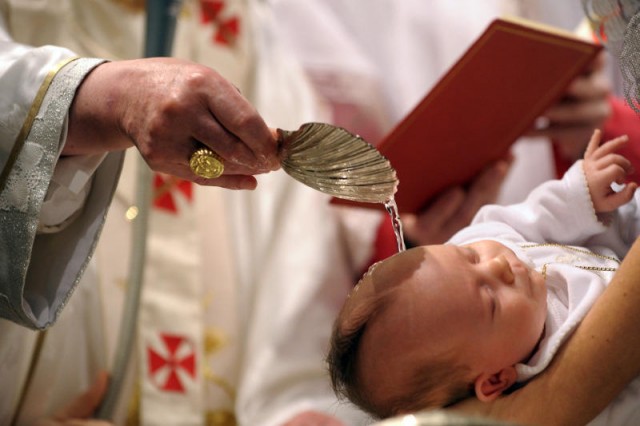Baptism Matters: Part 3 (Circumcision)
Over the last two days I have been looking at infant baptism. On Day 1 I looked at the evidence of infant Baptism in the New Testament. On Day 2 I demonstrated how the earliest Christians believed that Baptism actually does something to the soul of the one being baptized, thereby making it something that parents would naturally desire for their children.
Today’s entry will be a short post. All I would like to do is very briefly show the relationship between the circumcision of the Old Covenant and the Baptism of the New Covenant…

Covenant and kinship
Throughout Sacred Scripture, God made covenants with mankind. It was through these covenants that God entered into relationship with man. A covenant is an exchange, not of goods, but of persons. It is the means of building kinship bonds, a way of making a family.
In each covenant, Man and God pledged themselves to one another, in much the same way that a man and a woman do when they enter into the covenant of marriage. These covenants culminated in the New Covenant brought by Jesus and sanctified in His blood.
“You see that sharp stone over there?”
In the Old Testament, we are told of several different covenants that God made with mankind. There’s one in particular to which I would like to draw your attention, and that is the covenant of Abraham since it in this covenant that circumcision is introduced as the means of entry into the covenant:
“… This is my covenant, which you shall keep, between me and you and your descendants after you: Every male among you shall be circumcised. You shall be circumcised in the flesh of your foreskins, and it shall be a sign of the covenant between me and you. He that is eight days old among you shall be circumcised; …Any uncircumcised male who is not circumcised in the flesh of his foreskin shall be cut off from his people; he has broken my covenant.” – Genesis 17:10-12, 14
The sign which attended Abraham’s covenant was the sign of circumcision. It was the means of entry into the covenant and took place on the child’s eighth day of life. The child entered into covenant with the Lord through the actions of the parent, in anticipation of the faith in which the child would be raised.
Circumcision of Christ
With this background, let us consider the words of St. Paul in his letter to the Colossians:
In [Jesus] also you were circumcised with a circumcision made without hands,
by putting off the body of flesh in the circumcision of Christ;
and you were buried with him in baptism,
in which you were also raised with him through faith in the working of God,
who raised him from the dead. – Colossians 2:11-12
Here we see Paul draw a link between the rite of the Old Covenant and the Sacrament of the New Covenant. He shows that Baptism is the entry into the New Covenant of Christ in the same way that circumcision was entry into the covenant of Abraham.
Consistent Covenant Logic
Without baptism of infants, the First Century Jewish converts to Christianity would have been put into a very odd position. Consider a husband and wife with a six-month old son. Wouldn’t it have seemed strange to tell the parents that, although their son had previously entered into the Old Covenant by circumcision when he was only eight days old, that he would now have to wait about a decade before he could enter into the New Covenant through Baptism? In fact, wouldn’t that mean that, at least in this respect, the New Covenant is inferior to the Old Covenant? After all, it delays the child’s entry into God’s covenant family by about decade?
If an infant could enter into the Abrahamic covenant through the faith of the parent, why would we expect it to be any different with Christ’s covenant? If there were no waiting for the “the age of reason” prior to circumcision, why should we wait for “the age of reason” prior to Baptism?
(Tomorrow when we look at the witness of history, we will see that some people in the Early Church did think that baptism should be delayed…but only until the eighth day so as to more perfectly parallel the Old Covenant ritual of circumcision, but I’m getting ahead of myself, we’ll look at that tomorrow)
Converts and Cradles
I think this parallel of baptism to circumcision is particularly useful in responding to a certain kind of argument used against infant baptism. Some Protestants will reference passages in Acts of the Apostles (e.g. Acts 8:26-40) and point out that all the baptisms described there are preceded by an act of faith. The argument is then made that, since infants can’t make a profession of faith, they therefore can’t be baptized. In response to this argument, I think we can simply ask whether the same logic is applicable to circumcision…
If an adult male wants to convert to Judaism, it will be because he has come to faith in the God of Abraham. He will therefore seek circumcision in order to enter into the covenant of Israel. Here we see an act of faith preceding circumcision. Since we know that this is how an adult comes to God, if we applied the same kind of logic described in the previous paragraph, we’d have to conclude that children therefore cannot be circumcised since they cannot make an act of faith! However, we know that this has never been the practice of Judaism and that babies have always entered into covenant through circumcision. An act of faith is required for an adult convert, but not for an infant. What was true for Old Covenant circumcision is true for New Covenant Baptism.
Tomorrow I’ll finish this series by looking at the witness of Christian history…


